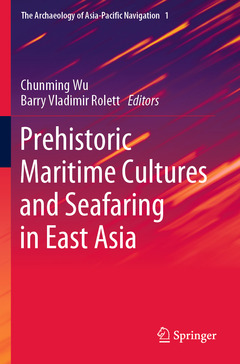Description
Prehistoric Maritime Cultures and Seafaring in East Asia, 1st ed. 2019
The Archaeology of Asia-Pacific Navigation Series, Vol. 1
Language: English
Subjects for Prehistoric Maritime Cultures and Seafaring in East Asia:
Prehistoric Maritime Cultures and Seafaring in East Asia
Publication date: 01-2021
Support: Print on demand
Publication date: 01-2021
Support: Print on demand
Prehistoric Maritime Cultures and Seafaring in East Asia
Publication date: 12-2019
Support: Print on demand
Publication date: 12-2019
Support: Print on demand
Description
/li>Contents
/li>Biography
/li>Comment
/li>
This book focuses on prehistoric East Asian maritime cultures that pre-dated the Maritime Silk Road, the "Four Seas" and "Four Oceans" navigation system recorded in historical documents of ancient China. Origins of the Maritime Silk Road can be traced to prosperous Neolithic and Metal Age maritime-oriented cultures dispersed along the coastlines of prehistoric China and Southeast Asia.
The topics explored here include Neolithisation and the development of prehistoric maritime cultures during the Neolithic and early Metal Age; the expansion and interaction of these cultures along coastlines and across straits; the "two-layer" hypothesis for explaining genetic and cultural diversity in south China and Southeast Asia; prehistoric seafaring and early sea routes; the paleogeography and vegetation history of coastal regions; Neolithic maritime livelihoods based on hunting/fishing/foraging adaptations; rice and millet cultivation and their dispersal along the coast and across the open sea; and interaction between farmers and maritime-oriented hunter/fisher/foragers. In addition, a series of case studies enhances understanding of the development of prehistoric navigation and the origin of the Maritime Silk Road in the Asia-Pacific region.
Part I: Neolithic and Metal Age Maritime Cultures of South China and Southeast Asia.- 1 A Synthetic Analysis of the Neolithic Origins of Eastern and Southeastern Asia's Maritime Silk Road.- 2 A Maritime Route Brought First Farmers to Mainland Southeast Asia.- 3 The Origins, Expansion, and Decline of Early Hunter-Gatherers along the South China Coast.- 4 Pollen Evidence for Human-Induced Landscape Change Reveals the History of Agriculture Development in Southeastern China.- 5 Subsistence Patterns Associated with Shell Middens from the Pre-Qin Period in Coastal Region of China.- 6 A Preliminary Analysis of the Development of Neolithic Culture in Coastal Region of Guangdong.- 7 Early Maritime Subsistence and Adaptive Ocean Cultures along the Beibu Gulf Coast.- 8 The Late Neolithic to Early Bronze Age on the Northeastern Coastal of Vietnam.- 9 Why Rice Farmers Don't Sail: Coastal Subsistence Traditions and Maritime Trends in Early China.- Part II: Prehistoric Seafaring and Exchange: From Coastal Waters to the Open Sea.- 10 Social Reciprocity Facilitated Overseas Exchange in Early Austronesian Cultures.- 11 Perspective on Early Holocene Maritime Ethnic Groups of the Taiwan Strait Based on the “ Liangdao Man” Skeletons.- 12 Coast to Coast: The Spread of Cereal Cultivation in the Taiwan Strait Region before 3500 BP.- 13 A Study on Geometric Stamped Pattern Pottery and the Early Maritime Cultural Interactions between Mainland China and Taiwan.- 14 Tapa Beaters from 5000 to 4200 BP in Taiwan.- 15 Double-Shouldered Barkcloth Beaters and Prehistoric Seafaring in South China and Southeast Asia.- 16 Prehistoric Migration and Cultural Change in the Philippines Archipelago.- 17 Prehistoric Ryūkyūans Seafaring: A Cultural and Environmental Perspective.
Chunming Wu ( B.A. and M.A. in Archaeology and PH.D. in Chinese History from Xiamen University) is currently a researcher at Xiamen University’s Center for Maritime Archaeology. Dr. Wu’s interests are in the field of maritime archaeology, and the prehistoric culture and early aboriginal ethno- history of southeast China and Southeast Asia. He was awarded a visiting scholarship by the American Council of Learned Society & Luce Foundation at the University of Hawaii at Manoa, and Harvard Yenching Institute, Harvard University.
He has published 6 monographs: Archaeological Research of the History and Cultures of Prehistoric Aboriginals in Southeast China (1999), Archaeological Research of Capital of Min-Yue Kingdom of Han Dynasty(1998), The Shipwreck Archaeology in Seas Surrounding China (2003), Maritime Archaeology (2007), The Maritime Cultural Interaction between Indigenous Yue and Austronesian (2012), The Archaeological and Historical Research on the Maritime Cultural Heritage (2016), and more than 150 academic papers.
Barry Vladimir Rolett (Pomona College, B.A.; Yale University, M.Phil. and Ph.D.) is a professor of Anthropology at the University of Hawaii at Manoa. He has conducted archaeological research in Polynesia and on the coast of southeast China. Polynesian origins can be traced to southeast China, explaining why his research drew him there.
Dr. Rolett's work in China is collaborative and interdisciplinary, investigating Neolithic cultures, maritime adaptation, the spread of rice agriculture and the ultimate origins of the Polynesians. As part of this work, he helped initiate the first Sino-American collaboration for archaeological research in Fujian.
In the Marquesas Islands of French Polynesia, Dr. Rolett has led more than twenty expe
Reveals the prehistoric maritime cultures and seascapes of East Asia Reconstructs Neolithic seafaringin and early navigation of the Asia-Pacific region Describes the prehistoric origin of the Maritime Silk Road in the seas surrounding China
© 2024 LAVOISIER S.A.S.




